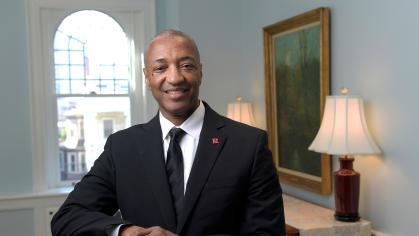Building an Inclusive Academy

Rutgers marked progress underway in its pursuit of becoming a more diverse, equitable and inclusive university at a summit this month, three years after the creation of University Equity and Inclusion and the release of the university’s first diversity strategic plan in March 2022.
Hundreds of Rutgers community members gathered in person and online on Nov. 15 for an update on the plan and conversations about what Rutgers is doing to achieve its institutional diversity goals. From a focus on hiring and retaining a diverse faculty to an initiative to increase supplier diversity, Rutgers leaders shared some of the steps taken in the last three years.

President Jonathan Holloway recounted the initiatives begun in the last three years for “Rutgers to become more intentional in our commitment to diversity, equity and inclusion, and to be a part of helping America to live up to the aspirations of its founding documents.” The work began with an equity audit of the central administration, which led to the development of the university’s first-ever diversity strategic plan.
“The plan is more than a to-do list of goals and action steps; it was a commitment of wills, a statement of purpose, a pledge to achieve a record that works toward diversity, equity and inclusion for the benefit of the university and the economy in partnership with and in service to the wider community,” Holloway said.
Progress toward that commitment includes efforts to hire more diverse faculty members over five years with the aid of a $45 million presidential diversity initiative. Those efforts have led to hiring half of the 52 expected new faculty so far and the launch of the Faculty Diversity Collaborative to extend efforts beyond recruitment to develop a sustainably supportive community for diverse faculty.

Collaboration across Rutgers is driving progress in the university’s commitment to diversity, equity and inclusion, Enobong (Anna) Branch, senior vice president for equity, said at the diversity plan progress summit.
“When we talk about progress, we are referring to a direction forward,” she said. “This nuanced definition means we understand at the outset that the work is dynamic and unpredictable factors may impact the way that we pursue progress, but it will not undermine our commitment to the purposeful pursuit of progress.”
Branch highlighted key initiatives undertaken, including the Inclusive Leadership Network and the launch of the Inclusive Leadership Academy to help leaders build an inclusive climate.
She also noted the creation of the Early Career and Racial Equity Program to promote an inclusive community, combat isolation and mitigate bias that can negatively shape the experiences of early-career faculty who are underrepresented in academia.
In addition, a partnership with the SEA Change Initiative at the American Association for the Advancement of Science aims to increase diversity, equity and inclusion in STEMM fields, science, technology, engineering, math and medicine.
In the coming weeks, Branch said University Equity and Inclusion will release a pilot Progress Inventory to promote transparency and accountability for progress and capture our momentum. “More than a thousand submissions from across our university reflect the wide-ranging ways that our community is implementing the plan and moving forward to action,” Branch said.

Rutgers-Newark Chancellor Nancy Cantor tackled the future of diversity in higher education, particularly following the U.S. Supreme Court’s SFFA v. Harvard and SFFA v. UNC rulings, effectively eliminating the use of affirmative action in college admissions, and a backlash against DEI efforts across the country.
To recapture momentum and regain public trust locally, Cantor said universities need “to take numbers seriously by recognizing that there is a highly diverse and expansive talent pool growing by the day in our own backyards.”
“We need to spread the word and action behind our commitment to reaping the direct benefits of diversity in everything we do, from the curriculum we teach and the people from whom we learn, to the disciplinary and interdisciplinary teams in which we do our research, to the operational units who make the organization work, and as importantly, across our many interactions with community collaborators beyond the gates of the university,” Cantor said.




